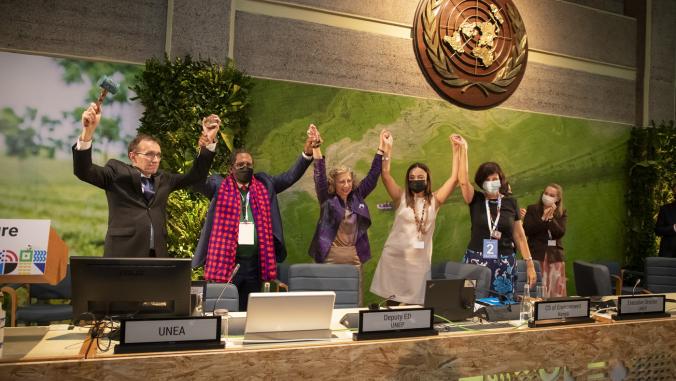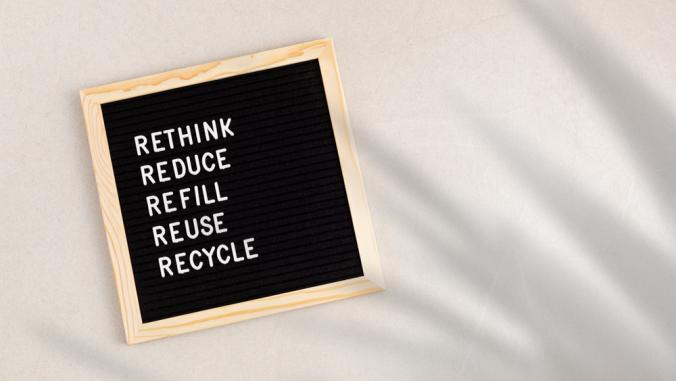4 ways your business can talk circular (without talking in circles)
Skip the buzzwords and focus on how circularity can improve products and the entire customer experience.

This article is drawn from the Circular Weekly newsletter from GreenBiz, running Fridays.
As the circular economy emerges from the margins to the mainstream, companies across industries are beginning to implement circular products, services and business models. But this transformational approach remains nascent — particularly in U.S. markets — and most customers, even the most sustainability-savvy, are not yet familiar with the concept. To the extent that they are, they often mistakenly see circularity akin to "recycling 2.0."
Customers say they want to do the right thing, and 87 percent say they will make purchases based on a company's alignment with their own values, according to the 2017 Cone Communications CSR Study. But it’s unclear how much they walk their talk. Some blame goes to companies, which often fail to tell compelling stories that entice customers to make the changes in purchasing habits needed for circular products and services to succeed in the marketplace.
Accordingly, companies must be more creative, clear and careful in messaging circularity to engage customers. To help steer businesses in the right direction, the U.S. Chamber of Commerce Foundation released a publication this week on Messaging the Circular Economy, and I encourage you to read the full report. The foundation gathered perspectives from a wide range of businesses, consultancies, trade associations, communications firms, academia and other stakeholders (including ours at GreenBiz Group) to fill the gap in the literature about how companies can most effectively communicate about their circular ambitions, products and service offerings.Consumers often mistakenly see circularity akin to 'recycling 2.0.'
From my perspective, here are four tips to help your company get started on telling your circular economy story:
1. Talk products, not systems: While your company may be thinking about circularity as a systems-level ambition or aspiration, customers are engaged in a specific product or service. Start there. Focus your stories on the customer’s experience within your circular narrative or risk getting caught in having to give overly complicated explanations.
Adidas is working to transform "threat into thread," turning marine plastics into material for shoes. The footwear and apparel company also invests in product takeback, redesign, recycling infrastructure and decreased reliance on virgin plastics through a partnership with Parley for the Oceans. However, Adidas focuses its messaging specifically on how customers are helping to end plastics pollution in the ocean.
2. Help customers help you: To effectively move products and materials along a circular path, you’ll need to explain how customers can (and must) help — and why it’s in their interest to do so. Whether you’re asking them to return products at the end of their usable life or dispose of them by recycling or composting, customers are responsible for ensuring that materials continue to flow through industrial systems rather than ending up in a landfill (or worse, an ocean). You can’t engage in circularity without their help.

3. Emphasize customer benefits: Customers want better products and experiences; sustainability — or circularity — is an ancillary benefit. What aspect of a circular product or service benefits the consumer, and how? Does it cost less, improve durability, perform better or offer other tangible benefits? Focus on the attributes that circularity creates rather than marketing the process.
Philips Lighting’s circular business model emphasizes "hassle-free savings with optimized performance." Customers save money by paying only for the light they use while ditching the hassle of replacing and disposing of burned-out bulbs as well as navigating upgrades to the latest lighting technology. The shift from selling lighting to offering illumination as a service highlights convenience and an improved consumer experience, potentially at a lower cost.
4. Don’t do it: Ultimately, the concept of the circular economy is still in its early days and it may not yet make sense to use this term in public-facing communications. While it may be tempting to adopt the latest buzzword, it could add unnecessary market confusion and stoke further misunderstanding about what circularity is and isn’t.
Despite Apple’s groundbreaking goal to use only recycled or renewable materials in its products, the company doesn’t refer to circularity in its marketing or sustainability report (PDF). Instead, Apple talks about product recycling, takeback and durability and emphasizes "mining less from the earth and more from old devices."
The dynamic circular economy landscape and marketplace is evolving quickly, and so, too, should your messaging. Start by using the circular economy framework as an internal tool to think about optimizing material flows, design and production systems. Make sure your company can answer the question, "What happens to products next?" (and even "What happens after that?") before touting closed-loop solutions. That is, if it only has one more life, is it truly circular?The dynamic circular economy landscape and marketplace is evolving quickly, and so, too, should your messaging.
In the end, circularity is a business framework and not a marketing vehicle — at least, not yet. Focus first on building a circular story before communicating about it.
Have you heard? We’ve just announced Circularity, GreenBiz’s newest event brand focused squarely on the circular economy. The premiere event, Circularity 19, will be June 18-20 in Minneapolis. We’re extremely excited about the launch. I encourage you to read about our intentions, nominate a speaker or session and join us in the Twin Cities.





